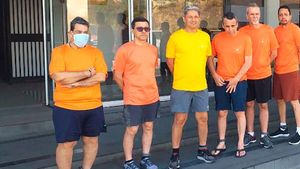The world of space exploration often finds itself at the crossroads of technological advancements and unforeseen challenges. Recently, the astronauts aboard Boeing's Starliner, Suni Williams and Butch Wilmore, faced unexpected delays on their mission, which has drawn significant attention.
Originally slated for a brief stay aboard the International Space Station (ISS), the astronauts have been waiting to return home for over two months due to propulsion failures and helium leaks experienced by the Starliner spacecraft. What was meant to be the spacecraft's first manned test flight has turned out to be quite complicated.
NASA had initially estimated they could safely keep the astronauts on board for 45 days, but they've since extended this duration to 90 days as officials work to resolve the issues plaguing their spacecraft. Steve Stich, NASA's commercial crew program manager, emphasized the importance of safety, stating, "We’ll come home when we’re ready."
The mishaps with the Starliner didn’t just arise out of the blue. Shortly after launch, five thrusters failed, raising serious concerns about the spacecraft's readiness for the return trip.
To tackle this, engineers have been running various tests to pinpoint the problems. They have successfully activated four of the failed thrusters, but lingering questions about the Starliner’s safety continue to loom large.
While stuck inside the ISS, the astronauts have not been idle. Instead, they’ve taken this time to assist with scientific experiments and maintenance tasks among their international peers aboard the space station.
This scenario is not entirely new, as NASA’s Frank Rubio also experienced prolonged confinement on the ISS due to vessel complications earlier. NASA has been cautious about labeling the situation as 'stranded,' reiteratin'=g they're technically safe and can use the extra time for valuable research work.
Interestingly, SpaceX’s Crew Dragon has been put on the table as an alternative return option should the Starliner issues persist. Adapting crew assignments for this would be tricky, but it reflects the agency’s commitment to bringing the astronauts back safely.
Although the astronauts had initially planned to check on the Starliner post-launch, those checks are long complete. Their extended visit, combined with mounting delays, seems to amplify the pressures they face during this unique chapter of their mission.
Sharing cramped quarters with seven other international astronauts, the duo’s schedules have remained packed. They continuously adapt to demanding workloads contrasting with the unique, timeless experience of floating above the Earth.
“That’s her happy place,” remarked Williams’s husband, highlighting the sentiment shared among many astronauts who thrive on their responsibilities, no matter the circumstances. Living conditions can feel cozy yet limited, with funny situations arising like Wilmore taking naps outside his sleeping bag due to space constraints.
A welcome boost has been the successful delivery of provisions and fresh clothes, enhancing their daily comforts amid the novelty of the extended stay. The recent supplies alleviated some anxieties surrounding dwindling resources.
Time is also proving to be a curious concept for the astronauts. When engulfed with busy schedules, time can slip by quickly, whereas longer periods of waiting can stretch indefinitely, creating psychological challenges.
Navigators strive to keep their spirits up, but the uncertainty surrounding their eventual return carries its emotional weight. Williams has expressed optimism, enjoying her experience on the ISS, yet the unanswered questions linger heavy at times.
Remarkably, this extended mission showcases the human spirit’s resilience and adaptability. The astronauts navigate their tasks, share laughs, and embrace the uncertainty, all contributing to the fabric of their extraordinary experience.
With anticipation building, all eyes are now focused on NASA and Boeing. Will they find solutions to restore the Starliner’s safe status, or will the plan shift to SpaceX’s Crew Dragon for extraction?
The outcome will reverberate beyond just the astronauts, shaping the future relationship between Boeing and NASA as they make progress together. This unexpected summer adventure ends with valuable lessons learned and memorable tales awaiting them upon their return to Earth.
Meanwhile, other noteworthy events have filled the international space stage. The Russian cargo spacecraft Progress MS-28 recently performed successful operations by transporting supplies to the ISS.
Launched from Baikonur Cosmodrome, this vessel delivered approximately 2,621 kg of supplies to the space station, including food, water, equipment, and propellant. This mission continues to underscore the importance of international collaboration to sustain experiments and living conditions thousands of miles above our planet.
On the expedition front, Russian cosmonaut Oleg Kononenko recently led another mission to address complications with the ISS’s external equipment during his spacewalk. Encountering unexpected situations, like spotting holes on the radiator panels, kept the team on their toes with real-time problem solving.
Kononenko and his crew faced the unusual occurrence of encountering residual coolant during their activities, leading to their immediate directive to vacate the area. Thankfully, standard safety protocols were followed, ensuring the crew returned unscathed.
Delivery of supplies and handling of unexpected equipment malfunctions exemplify the chaotic yet thrilling nature of life aboard the ISS. Being prepared for the unpredictability is key to overcoming challenges faced by astronauts.
Both NASA and Roscosmos are striving to communicate updates to the public about their missions, assuring reigning concerns about astronaut safety and equipment reliability. These events highlight how both organizations balance the pursuit of knowledge with the unforeseeable nature of space exploration.
Whether overcoming technology failures like the Starliner’s or addressing coolant leaks during spacewalks, astronauts continue to forge paths of progress and discovery. Their experiences remind us of the trials many encounter amid remarkable feats of innovation, giving hope for what the next challenges may yield.



